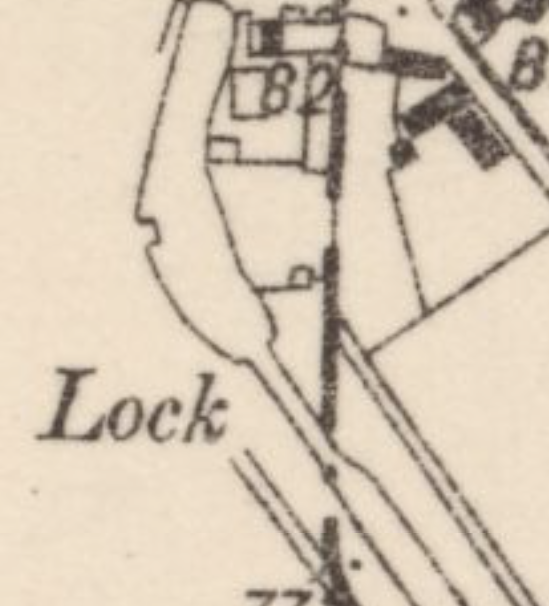Stabling Horses Overnight
The late Bill Moody was born in the former lockkeeper’s cottage in the village. Interviewed in 1980 he recounted that the corrugated iron shed (once used by Edmund Loughlin as a small byre but now demolished) to the north of the bridge was originally used as stabling for the horses of barges moored overnight at ‘the harbour’. However, a report in the Newry Telegraph of 12th March 1907 mentions stables at the rear of the lockkeeper’s cottage.
Spending A Penny?

In the 1960s, if you looked at the very bottom of Henry Clarke’s garden, built into the wall separating the garden from the area to the north of Moody’s lock, you would find the remains of a small stone building, with its roof and most of its walls collapsed. And if you looked on the very first OS map from the 1830s it was clearly visible, so it was built at least ~200 years ago. If you clambered inside, you would find that it was a side-by-side, three-seater toilet- a large plank of wood with three holes in it! It is the small square building shown at the centre of this 1905 OS map.
It makes not sense to associate it with the property – it was such a long way from the house and businesses. The most likely explanation is that it was for the use of the lightermen on the canal – though why they needed three seats is a mystery! Or perhaps it was used for comfort breaks by passengers on the Moyallen Quakers’ passenger-boat service while it transited the lock?
Vandalism
In late May 1829, a Portadown mob prevented a lighter called “The Union” from transporting a load of potatoes south for export, despite there being no shortage of potatoes or other food in the area! A group of Poyntzpass men were hired to protect the boat on its journey from Tandragee to Newry. The following day, the canal bank was deliberately breached near Moyallen to lower the water level and further hinder the boat’s progress. The Newry Navigation Company immediately offered a reward of £20 for information leading to the conviction of the culprits – or £100 if you handled the prosecutions yourself and they were successful!
There was more canal vandalism in December 1847; the Ulster Gazette reported:
“A pack of ruffians, in the neighbourhood of Portadown, who style themselves “Tommy Downshires” dug a trench four feet deep across the Newry Canal, but their evil intentions…were frustrated. The lock keeper having discovered the mischief in time, repaired the bank. The night after the following notice was posted near the place...
“Tommy Downshires again. You think you have the Madden and Park boys settled and transported but you are far mistaken. We are intending to watch the merchants of the canal and mark the consequence.”
Referring no doubt to some of their comrades in iniquity who were tried and transported at our last assizes for plundering the provision boats last winter on the canal. The Newry Navigation Board have offered a reward for the discovery of the gang.”
So Many Drownings
Many people have drowned in the canal during its 280-year existence. Between 1881 and 1929 alone, PRONI records inquests on at least 29 such deaths, at least one every couple of years. Often, those who died were either unattended young children or adults who had been drunk. Newspapers also published frequent reports of people being rescued after falling into the canal.
On 12th March 1807, Phelemy McKeown, a blacksmith, drowned in the canal at Scarva. He appears to have gone to mourn the accidental drowning of his brother three years earlier while drunk, “as was frequently the case” according to the Belfast Commercial Chronicle and was found drowned at the exact same location!
At Jerrettspass, the canal was particularly dangerous; in 1838, the Newry Telegraph reported:
“An inquest was held…upon the body of Henry Murtagh, who had been drowned… The deceased, accompanied by his father and a servant girl, were returning from Newry market, driving a horse and cart. Their road lay along the Newry Canal. On reaching the bridge at Gerrard’s Pass, the son who was sitting on the shafts of the cart and driving, became afraid to proceed, in consequence of the extreme darkness of the night, and requested his father to return for light to a house not far distant…in the meantime, however, the horse became restive, and precipitated himself with the cart, upon which sat the driver and the maid-servant, into the Canal.
The girl was soon after rescued from the water, but the son unfortunately perished. We understand that no fewer than six individuals have, within a short period, lost their lives at the same spot. There is neither high embankment, range wall, nor even simple rail there to protect the traveller from the Canal; and as the turn from the road to the bridge is extremely short and abrupt, the only wonder is, that, in these dark nights, the casualties are not more numerous.”
Poyntzpass Lockkeeper Drowns
Among the 20th century casualties was William Moody, aged 84, lockkeeper at Poyntzpass, who drowned there on Christmas Eve, 1906. He had been lockkeeper for over 30 years and had succeeded his father in the post, as was common practice. William’s own son, Arthur Moody, was almost immediately appointed to succeed him.
George Hall had appointed lockkeeper of No. 10 lock in 1830 “while still quite a child” on the death of his father Walter and held the position for more than 80 years!
On 7th June 1915, the 16-month-old daughter of Patrick McVeigh, his successor, drowned after falling into the canal. And on 25th April 1930, 15-year-old Kitty McVeigh fell off her bicycle into the canal at the same lock, and drowned while her 8-year-old brother watched, unable to help.
The most recent such press report was a 17-year-old youth who drowned in the canal in Newry in 2001.